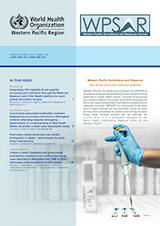Community-associated methicillin-resistant Staphylococcus aureus infections in Aboriginal children attending hospital emergency departments in a regional area of New South Wales, Australia: a seven-year descriptive study
DOI:
https://doi.org/10.5365/wpsar.2017.8.1.014Abstract
Objective: Community-associated methicillin-resistant Staphylococcus aureus (CA-MRSA) can cause bacterial skin infections that are common problems for Aboriginal children in New South Wales (NSW). MRSA is not notifiable in NSW and surveillance data describing incidence and prevalence are not routinely collected. The study aims to describe the epidemiology of CA-MRSA in Aboriginal children in the Hunter New England Local Health District (HNELHD).
Methods: We linked data from Pathology North Laboratory Management System (AUSLAB) and the HNELHD patient administration system from 33 hospital emergency departments. Data from 2008–2014 for CA-MRSA isolates were extracted. Demographic characteristics included age, gender, Aboriginality, rurality and seasonality.
Results: Of the 1222 individuals in this study, 408 (33.4%) were Aboriginal people. Aboriginal people were younger with 45.8% aged less than 10 years compared to 25.9% of non-Aboriginal people. Most isolates came from Aboriginal people who attended the regional Tamworth Hospital (193/511 isolates from 149 people). A larger proportion of Aboriginal people, compared to non-Aboriginal people, resided in outer regional (64.9% vs 37.2%) or remote/very remote areas (2.5% vs 0.5%). Most infections occurred in summer and early autumn. For Aboriginal patients, there was a downward trend through autumn, continuing through winter and spring.
Discussion: Aboriginal people at HNELHD emergency departments appear to represent a greater proportion of people with skin infections with CA-MRSA than non-Aboriginal people. CA-MRSA is not notifiable in NSW; however, pathology and hospital data are available and can provide valuable indicative data to health districts for planning and policy development.
References
Thomas S, Crooks K, Taylor K, Massey PD, Williams R, Pearce G. Reducing recurrence of bacterial skin infections in Aboriginal children in rural communities: new ways of thinking, new ways of working. Australian Journal of Primary Health. 2017.
Centres for Disease Control and Prevention. Active Bacterial Core surveillance. [cited 2016 29 August]. Available from: http://www.cdc.gov/abcs/reports-findings/survreports/mrsa11.html.
Gosbell I. Managing MRSA infections in the community. Medicine Today. 2012;13(4):69-73.
Coombs GW, Daley DA, Pearson JC, Nimmo GR, Collignon PJ, McLaws M-L. Community-onset Staphylococcus aureus Surveillance Programme annual report, 2012. Commun Dis Intell. 2014;38(1):E26-S36.
Tong SY, Bishop EJ, Lilliebridge RA, Cheng AC, Spasova-Penkova Z, Holt DC, et al. Community-associated strains of methicillin-resistant Staphylococcus aureus and methicillin-susceptible S. aureus in indigenous Northern Australia: epidemiology and outcomes. Journal of Infectious Diseases. 2009;199(10):1461-70.
Hedrick J. Acute bacterial skin infections in pediatric medicine. Paediatric Drugs. 2003;5(Suppl 1):35-46.
Hunter and New England Health Pathways. Management of Individuals with skin and soft tissue infections. NSW Health, NSW, Australia. 2016 [cited 2016 30 August]. Available from: http://www.health.nsw.gov.au/Infectious/factsheets/Documents/MRSA_manag_flowchart_clinicians.pdf.
New South Wales Health. Local Health Districts and Specialty Networks, 2016 [11 Aug 2016]. Available from: http://www.health.nsw.gov.au/lhd/Pages/default.aspx.
HealthStats NSW. Population by Aboriginality. 2016 [cited 2016 20 July]. Available from: http://www.healthstats.nsw.gov.au/Indicator/dem_pop_atsi/dem_pop_atsi_lhn_snap.
Agostino J, Ferguson J, Eastwood K, Kirk M. Utilising data for a better understanding of disease (unpublished Masters thesis). Australian National University, Canberra, Australia. 2017.
Australian Bureau of Statistics. Australian Statistical Geography Standard (ASGC) Remoteness Structure 2011. Available from: http://www.abs.gov.au/websitedbs/d3310114.nsf/home/remoteness+structure.
Australian Bureau of Statistics. Australian Statistical Geography Standard (ASGC): Volume 1, 2011, . Available from: http://www.abs.gov.au/ausstats/abs@.nsf/Latestproducts/88F6A0EDEB8879C0CA257801000C64D9
Mermel LA, Machan JT, Parenteau S. Seasonality of MRSA infections. PLoS One. 2011;6(3):e17925.
Thomas DP, Anderson IP. Use of emergency departments by Aboriginal and Torres Strait Islander people. Emergency Medicine Australasia. 2006;18(1):68-76.
Bailie RS, Stevens M, McDonald EL. The impact of housing improvement and socio-environmental factors on common childhood illnesses: a cohort study in Indigenous Australian communities. Journal of epidemiology and community health. 2011:jech. 2011.134874.

